Curated by artists Elisabeth Condon and Carol Prusa, “POUR,” an exhibition that examines the use of poured paint in contemporary art practice, opens this week at the Schmidt Gallery, Florida Atlantic University, in Boca Raton, Florida. Condon, a painting professor at University of South Florida and Prusa, a painting prof at FAU, tapped Stephen Maine to write the essay, which references Pollock, Kaprow, Frankenthaler, Morris Louis, James Brooks and others.
Featuring work by Ingrid Calame,
Kris Chatterson, Roland Flexner, Angelina Gualdoni, Carrie Moyer,
Carolanna Parlato, David Reed, Jackie Saccoccio, and Carrie Yamaoka, the exhibition travels to Asya Geisberg and Lesley Heller galleries in April. Maine’s thoughtful essay is pasted below.
Contributed by Stephen Maine / Paint is mercurial. Painters exert tremendous energy trying to make paint conform to their wishes (or using paint to divine what their wishes are), but the stuff sometimes seems to have a will of its own. Some painters find it helpful to let paint do what it does independently of their intervention — to permit it to express its materiality as an amorphous film that adheres to solids having a higher surface energy — whereupon that fluidity can be channeled toward pictorial purpose. On a small scale, perhaps, but with far-reaching implications, this picture-making strategy embraces atrophy and randomness as paint oozes and flows, unartfully finds its boundaries and configurations, shapes itself to some extent. To just what extent, before the painter diverts the random toward formal and conceptual signification, is of course a matter of individual temperament and specific creative aims.
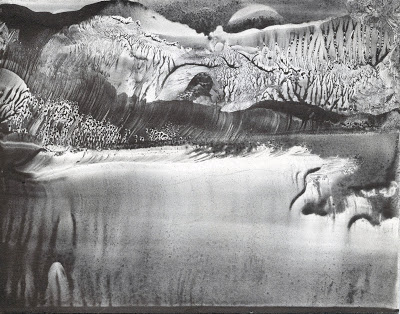
“POUR” presents the work of nine contemporary artists who, in the process of locating their imagery, variously respond to and utilize the properties of paint (broadly defined) in its liquid state. Thus these artists, though they might allude to the visible world by way of depiction, engage with a subset of abstraction labeled the concrete. Because he grasped the necessity of allowing the physical characteristics of slippery, viscous paint to propel his pictorial intentions, Jackson Pollock is a pivotal figure in the historyof painting. Through consummate control of his material, he projected the illusion of immateriality, disembodiment, abandon — what Allan Kaprow described as “a sort of ecstatic blindness” to painting’s proprieties that had profound ramifications for the production, indeed the definition, of art.1
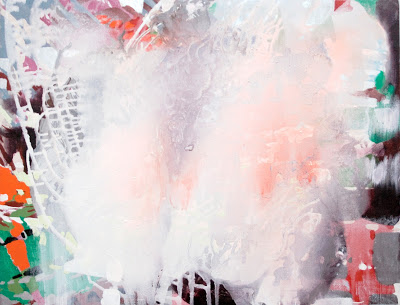
The paradox of dissolution via materiality in Pollock’s great mid-century paintings is subject to wide-ranging interpretation. It has been seen as a response to social and historical vaporizing brought about by global war and the atomic bomb, and as the visualization of psychic energy liberated by boundless space.2 In our day, trauma is a no less efficacious spur to invention; like everyone else, painters in the early years of the twenty-first century work in the long shadow of 9/11 and at the frontier of digital culture, of cyberspace. To pursue chance effects and happenstance as a picture-making method is to enact, on a private scale, very civic concerns regarding both the uncertainty and the potential of the unforeseen, and to raise questions about the extent of individual agency and the illusions we harbor of what we can control.
To take advantage of paint’s fundamental, bricks-and-mortar materiality might, in some cases, be implicitly to refute the ongoing wholesale digitalization of visuality that denies tactility as a painterly value. Computer screens don’t do “wet.” On the other hand, isn’t the Web itself becoming oceanic in scale, rolling on inexorably like an enormous wave, saturating our lives with verbal, visual and auditory information? (It even leaks.) In his essay “Liquid Rubens,” David Reed describes the fluid quality of light that emerges from the great Baroque painter’s repudiation of local color — color, that is, which characterizes an object by being contained within its border — in favor of a sort of environmental color that flows through and suffuses his pictures and is a characteristic of them as a unified whole.3 Wet paint spreads like this kind of light.
Then it dries. The volatile liquid state resolves into vapor and solid. As drying paint polymerizes it adheres to itself and to the substrate. (Painters who use acrylics must anticipate distinct color shifts, particularly darkening of glazes, in drying paint.) Paintings that were executed face- up become dislocated from that original relation to the earth when hung on the wall — if not actually defying gravity, well then flouting it just a little. This positional dislocation is a defining quality of paintings by Helen Frankenthaler, Morris Louis, James Brooks and others.
The tradition is rich but, as the range of work in POUR makes clear, its metaphorical and procedural possibilities are far from exhausted. For Carolanna Parlato, pouring offers the practical expedient of getting a lot of material and chroma into play swiftly, with a minimum of fuss. Finessing a balance of chaos and control, Roland Flexner leverages the mind’s iconophilia to extract images from the visually arbitrary. His ink drawings suggest fantastic landscapes’ antediluvian, apocalyptic, otherworldly. Kris Chatterson’s acrylic transfer method gives his paintings a forensic or evidentiary quality, a memory of spontaneity.
Ingrid Calame recombines her field notes — meticulous records of chance-pours-past — in paintings and drawings that compress time and abstract the “concrete.” Information also figures in Carrie Moyer’s hybrids of poured and painted shapes, which toy with the boundaries of representational legibility. Displaying a photographic look and sometimes-jarring color chords, David Reed’s paintings contain the sign of fluidity as extravagant arabesques in oils thinned to a glaze. The estranged relationship between gesture and color in Angelina Gualdoni’s paintings evokes a photographic double exposure, though they are not representational; two systems coexist without integrating. Pools of pungent blue paint that Carrie Yamaoka applies to reflective mylar transform the image of the exhibition space as if it were seen through a scrim, gel or haze. Many of Jackie Saccoccio’s paintings are formally resolved by means of a thin veil of paint that obfuscates features of the surface underneath it. This partial erasure complicates the reading of the painting, as the viewer pores over its surface as if deciphering runic inscriptions.
In the context of the contemporary metropolis, the idea of fluidity connotes mobility of all kinds, social agility, flexibility, adaptability: flow. It suggests familiarity with a diverse milieu and skill in navigating it. It is analogous to the peak experience for an artist in the studio or at the keyboard or in the concert hall, the very opposite of being stuck. Fluidity implies mastery, of which a significant aspect is knowing when and how to loosen one’s grasp of technique and permit the situation to shape itself. The ebb and flow of liquid pigment embodies, in material, plastic form, those preternaturally fruitful moments of creative endeavor when an exhilarating sense of freedom convinces us that anything is possible.
NOTES:
1 Allan Kaprow, “The Legacy of Jackson Pollock,” reprinted in Essays on
the Blurring of Art and Life. Edited by Jeff Kelley. Berkeley:
University of California Press, 1993.
2 2 See for example Katy Siegel, Since ’45: America and the Making of Contemporary Art. London: Reaktion Books, 2011.
3 David Reed, “Liquid Rubens: Rubens in Las Vegas.” From a talk at the
Guggenheim Hermitage Museum, Las Vegas, Nevada, May 12, 2006. Posted at http://www.davidreedstudio.com
“POUR,” featuring work by Ingrid Calame, Kris Chatterson, Roland Flexner, Angelina Gualdoni, Carrie Moyer, Carolanna Parlato, David Reed, Jackie Saccoccio, and Carrie Yamaoka. Curated by Elisabeth Condon and Carol Prusa. Schmidt Gallery, Florida Atlantic University, Boca Raton, FL. February 4 – March 15, 2012 Traveling to NYC April 25 – May 24, 2012, Asya Geisberg and April 24-May 24 at Lesley Heller, back room.
Related posts:
Elisabeth Condon: Walking in her own landscape
Parlato and Saccoccio: retooling gestural abstraction
Fall preview for painters


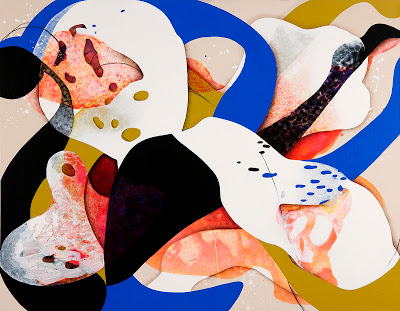





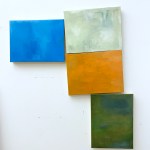
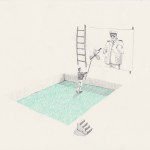
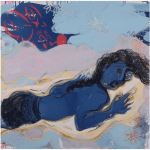






Elisabeth Condon is a Professor at University of South Florida, not Florida Atlantic University.
Corrected. Thx.
Sharon, thank you, as well as to Stephen Maine and all of the artists, whose works are so inspiring. There is a second catalog essay by Tyler Emerson-Dorsch, which you'll be able to read when the catalogs arrive at Lesley Heller Workspace and Asya Geisberg in April with the show.
The pictures are too beautiful! Thanks for your sharing.